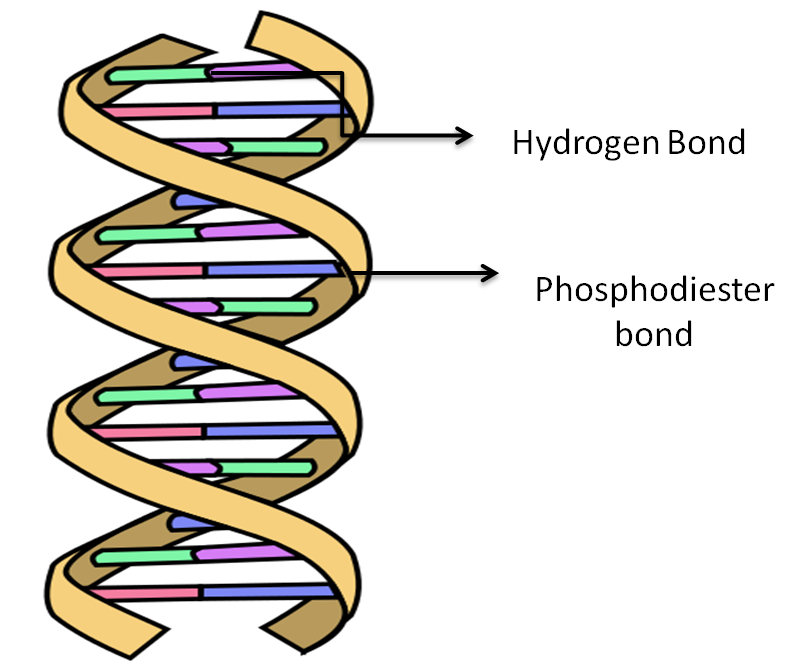
The two strands of DNA are held together by bonds of
(a) Nitrogen
(b) Oxygen
(c) Hydrogen
(d) Carbon
Answer
587.7k+ views
Hint: The structure of DNA is a double stranded molecule and is like a spiral staircase. The nucleotides are the railings of the staircase and nucleotides are like the steps of the staircase.
Complete step-by-step answer:
The stability of the DNA helix is provided by weak covalent bonds.
There are four types of nitrogenous bases in DNA, i.e Guanine, Cytosine, Adenine, and Thymine. The complementary base pairs of guanine with cytosine and adenine with thymine connect to one another by hydrogen bonds. The hydrogen bonds between complementary nucleotides keep the two strands of DNA helix together.
Additional Information:

- The nucleotide monomers in DNA are connected by a strong electromagnetic attraction called phosphodiester bonds. The phosphodiester bonds that join one DNA nucleotide to another always link the 3’ carbon of the first nucleotide to the 5' carbon of the second nucleotide.
- Hydrogen bonds exist between the two strands and form a base between the two strands of DNA. Each base can also form hydrogen bonds with water also. These hydrogen bonds are individually weak but collectively make strong.
- The A nucleotides are always hydrogen-bonded to T nucleotides with 2 hydrogen bonds.
- The G nucleotides are always hydrogen-bonded to C nucleotides with 3 hydrogen bonds.
- The hydrogen between the two DNA strands is a breakdown during DNA replication by the enzyme helicase or during denaturation at high temperature.
So, the correct answer is ‘hydrogen bonds’.
Note: -DNA, or deoxyribonucleic acid, is the hereditary material in mainly all organisms.
-DNA is located in the cell nucleus where it is called nuclear DNA, but a small amount of DNA can also be found in the mitochondria and chloroplast in plants.
-The information in DNA is stored as a code made up of four nitrogenous bases: adenine (A), guanine (G), cytosine (C), and thymine (T).
-There are three types of DNA- A-DNA, B-DNA, Z-DNA.
Complete step-by-step answer:
The stability of the DNA helix is provided by weak covalent bonds.
There are four types of nitrogenous bases in DNA, i.e Guanine, Cytosine, Adenine, and Thymine. The complementary base pairs of guanine with cytosine and adenine with thymine connect to one another by hydrogen bonds. The hydrogen bonds between complementary nucleotides keep the two strands of DNA helix together.
Additional Information:

- The nucleotide monomers in DNA are connected by a strong electromagnetic attraction called phosphodiester bonds. The phosphodiester bonds that join one DNA nucleotide to another always link the 3’ carbon of the first nucleotide to the 5' carbon of the second nucleotide.
- Hydrogen bonds exist between the two strands and form a base between the two strands of DNA. Each base can also form hydrogen bonds with water also. These hydrogen bonds are individually weak but collectively make strong.
- The A nucleotides are always hydrogen-bonded to T nucleotides with 2 hydrogen bonds.
- The G nucleotides are always hydrogen-bonded to C nucleotides with 3 hydrogen bonds.
- The hydrogen between the two DNA strands is a breakdown during DNA replication by the enzyme helicase or during denaturation at high temperature.
So, the correct answer is ‘hydrogen bonds’.
Note: -DNA, or deoxyribonucleic acid, is the hereditary material in mainly all organisms.
-DNA is located in the cell nucleus where it is called nuclear DNA, but a small amount of DNA can also be found in the mitochondria and chloroplast in plants.
-The information in DNA is stored as a code made up of four nitrogenous bases: adenine (A), guanine (G), cytosine (C), and thymine (T).
-There are three types of DNA- A-DNA, B-DNA, Z-DNA.
Recently Updated Pages
The number of solutions in x in 02pi for which sqrt class 12 maths CBSE

Write any two methods of preparation of phenol Give class 12 chemistry CBSE

Differentiate between action potential and resting class 12 biology CBSE

Two plane mirrors arranged at right angles to each class 12 physics CBSE

Which of the following molecules is are chiral A I class 12 chemistry CBSE

Name different types of neurons and give one function class 12 biology CBSE

Trending doubts
One Metric ton is equal to kg A 10000 B 1000 C 100 class 11 physics CBSE

What is 1s 2s 2p 3s 3p class 11 chemistry CBSE

Discuss the various forms of bacteria class 11 biology CBSE

State the laws of reflection of light

Explain zero factorial class 11 maths CBSE

An example of chemosynthetic bacteria is A E coli B class 11 biology CBSE




